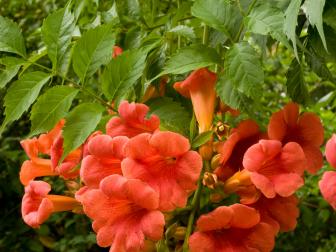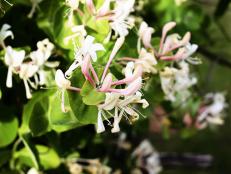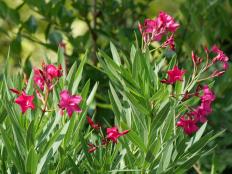Trumpet Vine Is a Beautiful But Invasive Plant
This perennial will give you flowers and attract swarms of hummingbirds all summer, but you’ll need to watch that it doesn’t take over your yard.

Trumpet vine is an easy-to-grow native plant that has masses of showy, yellow, orange or red trumpet-shaped flowers that hummingbirds adore. Sounds great, right? Well hold on before you plant it. The woody perennial vine can take over a yard in a single season in the warmest, wettest places, growing 30 and 40 feet tall and covering trees and fences faster than you say “Damn that invasive plant!” If you’re not vigilant, trumpet vine can escape your yard and choke out other plants in the surrounding landscape.

Shutterstock/Siriwat Chamnanyoch
That said, for people who live in arid climates, trumpet vines are a go-to plant. I and my neighbors in New Mexico adored our trumpet vines because they thrived in the infertile, hard-pan soil, survived on our paltry 15 inches of rainfall a year and endured tough Rocky Mountain winters. Trumpet vine brought a welcome shot of tropical color to the high-desert landscape.
In more hospitable climates, you’ll need work to keep your trumpet vine from being a menace. The U.S. Department of Agriculture lists the vine as an invasive weed. But they’re a lovely plant if used carefully. A trumpet vine is an excellent pick for a pollinator or hummingbird garden, attracting swarms of winged creatures all summer. You’ll have rafts of flowers for months, too. Keep those pruners on your hip, though.
Botanical Name: Campsis radicans
Common Names: Trumpet vine, trumper creeper, hummingbird vine
Hardiness Zones: 4 to 9
Bloom Time: June to September
Growing Trumpet Vine
If you live in an area with peak trumpet vine conditions, consider choosing a less aggressive species, like campsis grandiflora, native to Asia, or campsis x tagliabuana, a hybrid of the North American and Asian species, so you don’t have to work so hard to make it behave.
Trumpet vines prefer well-draining soil, but they’ll thrive in almost any soil. No need to add organic matter at the time of planting.
They grow in part shade to full sun, but you’ll get the most blooms in full sun.
Don’t plant trumpet vines too close to your house, outbuildings or driveways because the vine’s creeping roots can damage them.
Trumpet vines will need support, so plant them by a fence or trellis. Don’t let them grow on your house, as their aerial roots can damage the structure, and don’t let them climb a tree because the vine could strangle it.
Caring for Trumpet Vine
Water only as needed and don’t fertilize. Trumpet vines need no help from you to thrive. You just need to prune, prune, prune them so they’ll behave.
Pruning: Did we mention you need to prune these guys? It’s nigh impossible to overprune a trumpet vine. It’s so vigorous a grower it always comes back. Early in spring before new growth appears, cut the plant nearly to the ground, because aggressive pruning is the only way to keep it from taking over your yard.
Deadhead trumpet vine flowers after they bloom to keep the plant from reseeding and spreading. Flowers left on the vine will form 6-inch seed pods that will leave you with trumpet vine seedlings all over the place.
Pull up new shoots that pop up from their roots. Trumpet vine roots will send up shoots that turn into new plants. Whack those baby plants down as soon as you see them.
Pests and Problems
Trumpet vines are resistant to almost all diseases and pests. But it can be a pest itself if it takes over the yard. Here are two ways to kill trumpet vines without resorting to herbicide:
- Dig out the roots. Yes, it’s tough work, but digging out the roots by hand will get rid of the plant.
- Pour boiling, salted water on the plant’s root zone. Add a cup of rock salt to a gallon of boiling water and pour it over the vine’s root zone. You’ll need to do this several times to kill the entire plant. Look out, because this homemade plant killer will also kill other plants in the vicinity.
No Blooms
Trumpet vines can take several years to bloom. But if your vine is established and you still aren’t getting any flowers, here’s what could be the problem:
The plant isn’t getting enough sun. Put it in too shady a spot, and you won’t get blooms. Full sun yields the most blooms.
You pruned it at the wrong time. Trumpet vines bloom on new growth, so you must prune before new growth begins for the season, in earliest spring.
You overfertilized it. Unlike most plants, too much fertilizer will keep it from flowering. It’s unhappy if you overdose it with nitrogen. Also, why are you fertilizing a trumpet vine?
Toxicity
Trumpet vine's sap has a skin irritant that makes some people and livestock itch if they come into contact with it, hence one of its common names: cow itch vine.
Varieties of Trumpet Vine
‘Aurea’ is a cultivar with yellow blooms.
‘Flamenco’ produces orange flowers, grows 20' to 30' tall and is hardy in zones 4 to 10.
‘Chinensis’, also known as Chinese Trumpet Vine, is a different species. Campsis grandiflora doesn’t grow as large or as rapidly as the radicans species so plant this one if you fear a trumpet vine takeover. ‘Chinensis’ only reaches heights of 13' to 30' and is only hardy in zones 6 to 10. Cold weather kills it. It produces orange flowers.
‘Crimson Trumpet’ is a cross between the Chinese and American species. It produces salmon-red blooms and is more cold sensitive, and hardy only to zone 7. It’s a good choice, too, if you want a less aggressive plant.
Garden Design Suggestions
13 Flowering Vines for Year-Round Color 13 Photos
Flowering vines such as Trumpet Vine aren't just for gardeners with limited space. See some of our favorites for color through the seasons.
Use trumpet vines as a container plant. You get the nice blooms and hummingbirds without the takeover of your yard.
Plant trumpet vine in one of those 5-gallon plastic buckets sold by Lowes, Home Depot and Ace Hardware. Cut the bottom out of it, then put the container in a hole in the ground in your yard. The bucket will keep the vine’s roots from spreading. You’ll get trumpet vine without its nuisance aspects.
Use it as a privacy screen or groundcover. Trumpet vine can cover a fence or barren ground in a single season.














































